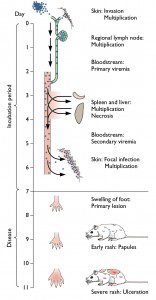

Dr. Fenner was a co-author of The Biology of Animal Viruses, first published in 1968. I still have my paperback ‘student’s edition’ which served as my virology bible during my years as a Ph.D. student. Later, when I was developing virology lectures for medical and graduate students, I relied on this book heavily. From the introduction:
During the last twenty years virology has developed into an independent science. It is now growing so rapidly that two new journals of virology were launched this year. Four major works on viruses of vertebrate animals have been published recently….However, none of these books deals in a comprehensive way with the broader biological principles of animal virology, which is the aim of this two-volume work.
The idea of presenting virology as a series of principles, not simply a list of viruses, was novel, and inspired us during the writing of Principles of Virology many years later.


Fenner was also well known for his work on rabbitpox. European rabbits were introduced into Australia for hunting in 1859, and lacking natural predators, they reproduced to plague proportions. The rabbitpoxvirus, myxoma virus, was released in Australia in the 1950s in an attempt to rid the continent of these rabbits. In the ï¬rst year, the infection killed the rabbits with a 99.8% mortality rate. By the second year the mortality dropped to 25%, and subsequently the rate of killing was lower than the reproductive rate of the rabbits, ending any hope for 100% eradication of the animals. The most important lesson from this incident is that the original idea to eliminate rabbits with a lethal virus was flawed, because powerful selective forces that could not be controlled or anticipated were at work. Fenner published a series of journal articles from 1950-1964 which carefully documented the changes in the virus and the host that occurred during this incident.
For more information on Dr. Fenner, see his interview from June of 2010 in The Australian, and a summary of his career at the Australian National University.
Fenner F (2010). Deliberate introduction of the European rabbit, Oryctolagus cuniculus, into Australia. Revue scientifique et technique (International Office of Epizootics), 29 (1), 103-11 PMID: 20617651
FENNER F, & WOODROOFE GM (1965). CHANGES IN THE VIRULENCE AND ANTIGENIC STRUCTURE OF STRAINS OF MYOMA VIRUS RECOVERED FROM AUSTRALIAN WILD RABBITS BETWEEN 1950 AND 1964. The Australian journal of experimental biology and medical science, 43, 359-70 PMID: 14343496

Pingback: Tweets that mention Frank Fenner, MD, 1914-2010 -- Topsy.com
Pingback: TWiV #110: CSI virology | Alan Dove, Ph.D.
Pingback: TWiV 110: CSI virology